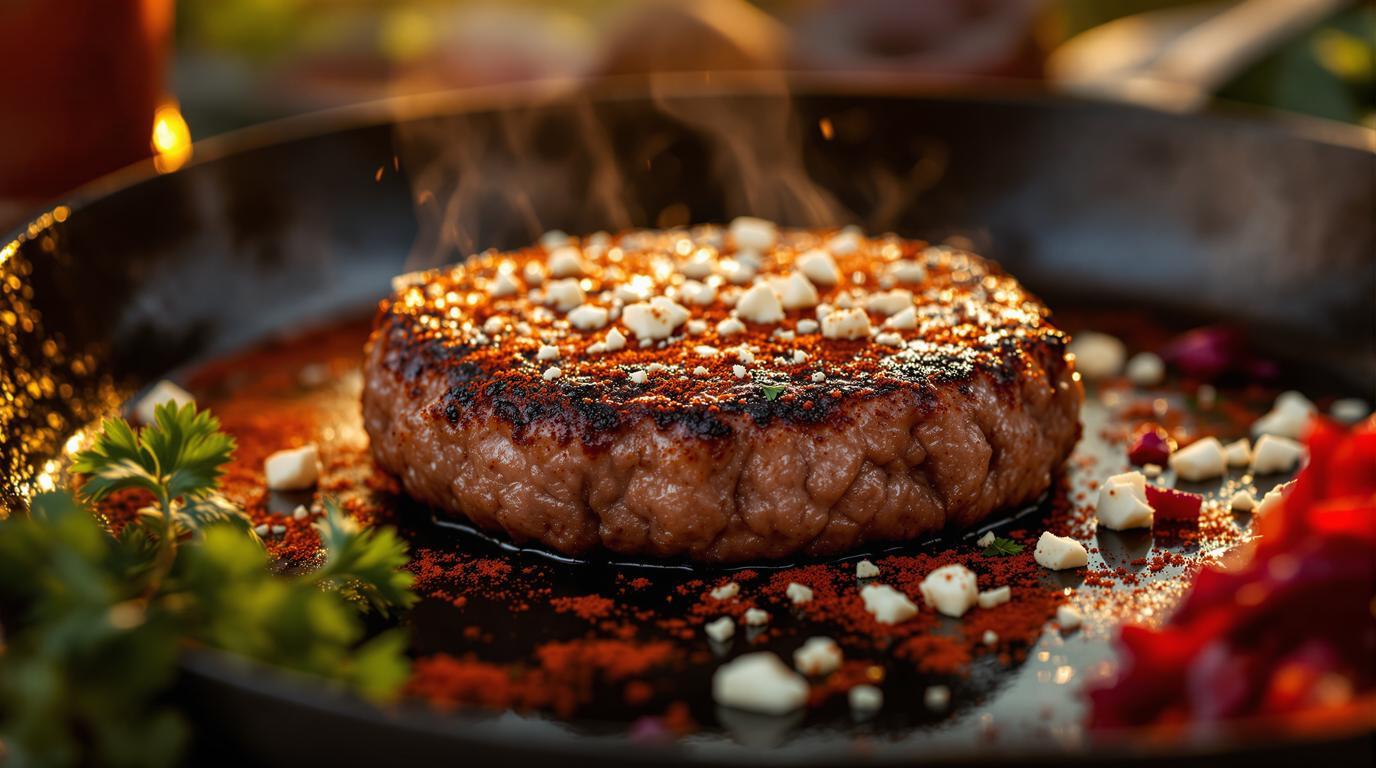There’s something deeply nostalgic about biting into a perfectly seasoned burger that takes you straight back to childhood backyard cookouts. In my grandmother’s kitchen, burgers were never just fast food – they were an art form. Her secret? A generous dusting of smoked paprika that transformed ordinary ground beef into something extraordinary. Growing up in a household where Central European and Middle Eastern flavors mingled freely, I learned early that the humble burger could be a canvas for bold, traditional flavors that crossed cultural boundaries.
The Story Behind Grandma’s Smoked Paprika Burgers 📖
My grandmother would tell stories of how smoked paprika traveled through 19th-century Europe, beginning with Hungarian traditions before merging with Middle Eastern spice routes. This burger honors that cross-cultural heritage, creating a flavor profile that’s simultaneously familiar and intriguingly complex. The first time I made these burgers for colleagues, even the vegetarians in the group asked for the recipe – though they substituted walnut-chickpea patties for the beef!
Essential Ingredients 🧾
The heart of this recipe is quality ground beef with enough fat (80/20 is ideal) to keep your patties juicy. The smoked paprika isn’t just a seasoning – it’s the soul of the dish, providing that distinctive smoky depth that elevates these burgers beyond the ordinary. If you can’t find smoked paprika, you can substitute ½ tablespoon regular paprika mixed with ¼ teaspoon liquid smoke, though it won’t quite capture the authentic flavor profile.
- 1 pound (454g) ground beef (80/20)
- 1 tablespoon smoked paprika
- 1 tablespoon garlic powder
- ½ teaspoon onion powder
- 1 teaspoon salt
- 1 teaspoon freshly ground black pepper
- ½ teaspoon cumin
- Pinch of cayenne pepper (optional)
- ¼ cup fresh flat-leaf parsley, finely chopped
Step-by-Step Instructions 📝
- In a large bowl, combine ground beef with smoked paprika, garlic powder, onion powder, salt, pepper, cumin, and cayenne if using.
- Sprinkle the chopped parsley over the mixture and gently fold everything together using your hands. Remember: overmixing will result in tough burgers!
- Divide the mixture into four equal portions and shape into ¾-inch thick patties. Create a slight depression in the center of each patty with your thumb – this prevents the burger from puffing up during cooking.
- For the best results, refrigerate the patties for 30 minutes before cooking to allow the flavors to meld and the structure to set.
- Preheat your grill or skillet to medium-high heat (about 375°F/190°C).
- Pat the patties dry with a paper towel before cooking to ensure a proper crust forms.
- Cook for 4-5 minutes per side until the internal temperature reaches 160°F (71°C).
- While the burgers cook, brush the inside of your burger buns with butter and toast them alongside the patties.
Chef’s Note: For exceptionally moist burgers, my grandmother would sometimes mix a beaten egg yolk into the beef. If you’re watching cholesterol, an alternative is to add 1 tablespoon of breadcrumbs soaked in 2 tablespoons of milk – it achieves similar tenderness with less fat.
Chef’s Secret Techniques 🤫
The biggest mistake home cooks make with burgers is pressing down on them with a spatula while they cook. This squeezes out precious juices, resulting in dry patties. Let them cook undisturbed, flipping just once. Also, season aggressively – beef needs more salt than you might think to bring all those flavors to life. If I’m cooking for guests who enjoy spicy food, I’ll sometimes add a hint of spicy-sweet elements to complement the smoky notes.
Serving & Presentation Tips 🍽️
These burgers shine with traditional toppings like sautéed onions or a mustard-based aioli, but don’t be afraid to experiment with creamy feta or pickled red cabbage for contrast. A smoked paprika aioli (mix 2 tablespoons mayonnaise with ½ teaspoon smoked paprika) creates a perfect finishing touch that reinforces the burger’s signature flavor.
Pair these burgers with a robust Cabernet Sauvignon or Tempranillo – the wine’s tannins and acidity cut through the richness beautifully. For a complete meal, serve alongside grilled vegetables or a simple herb salad dressed with lemon and olive oil – much like you’d find with other rich main courses.
These burgers have graced my family’s table for generations, evolving slightly with each cook who makes them their own. The technique for creating these deeply flavored patties can be applied to other proteins too – try it with pork or even plant-based alternatives. Whatever your preference, I hope these burgers bring the same joy to your table that they’ve brought to mine for decades. Cook with love, and the flavors will always shine through.
